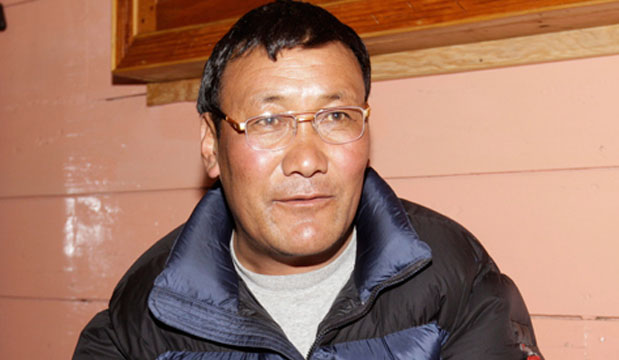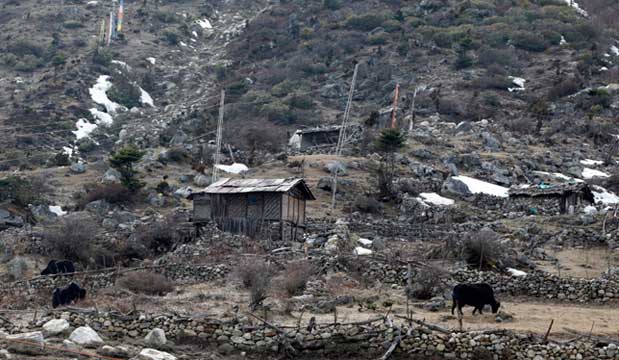By Ujol Sherchan, ICIMOD
The closure of the China-Sikkim northern border in the early 1960s dealt a big blow to animal husbandry (transhumant pastoralism) in North Sikkim. Since then, yak and sheep herders from Tibet have stopped coming to North Sikkim and those from North Sikkim have stopped grazing their animals in the Trans-Himalayan pastures of Tibet. A team from HI-AWARE, comprising staff from ICIMOD and The Mountain Institute (TMI)-India, conducted an interview with 45 year old Pema Thinley, a yak farmer from Gurudongmar in North Sikkim, at the Shvin Khyim Homestay in Lachen.
 Pema Thinley, Yak Farmer, North Sikkim
Pema Thinley, Yak Farmer, North Sikkim
Photo credit: Jitendra Bajrachaya/ ICIMOD
Q 1. Can you tell us briefly about the present state of animal husbandry north of Lachen?
Today, there are many factors that pose challenges and hardships for yak farmers, including fencing, which limits the land that can be grazed, landmines, feral dogs, snow leopards, and even heavy snowfall. Yak farming was never an easy job to begin with, although it has been part of the survival strategy of the Drokpas for centuries. Yak husbandry entails working in the most inhospitable terrain, including in the cold desert environment. I am beginning to think that I may be part of the last generation of Drokpas who are still maintaining this way of life. I doubt our children will take up yak farming. The mobile yak hair tents our ancestors used to live in and keep baby yaks in are no more to be seen; similarly, yak farming is probably on its last leg.
On the other hand, if you look at sheep farming, there is only one person I know of in Gurudongmar who grazes Tibetan sheep. His name is Singhy Drokpa and he owns about 113 sheep. He used to own more. He had 11 goths (‘pens’) three years ago, but now he has only one goth. Sheep grazing is a full-time job, unlike yak grazing, and shepherds-for-hire are difficult to find. Sheep husbandry is on the verge of dying out from this part of the world.
 Yak-herding Drokpa families’ temporary stone huts in Gurudongmar (at 5430 m), North Sikkim
Yak-herding Drokpa families’ temporary stone huts in Gurudongmar (at 5430 m), North Sikkim
Photo credit: Jitendra Bajrachaya/ ICIMOD
Q 2. You said you have 111 yaks. Where do you take your yaks to graze and what time of the year?
I have five yak herders working for me. They take my yaks to Tsho Lhamu, which is the origin of the Teesta River, and Gurudongmar from October through March, to Dhungu and Yangri (above Chopta valley) from April through June, and to Gaigung from July through September. The general walking distance between these places in terms of time is five hours from Tsho Lhamu/Gurudongmar to Gaigung, three hours from Gaigung to Dhungu/Yangri, and eight hours from Yangri to Tsho Lhamu/Gurudongmar. There are about 15 goths along these grazing routes and about 60 yak herders are active around here.
Q 3. Do you think that climate change has helped or hindered yak herding?
We used to get plenty of snowfall – about 5 feet or more – but now it is less, about 2 feet of snow in recent years. I do not know if less snowfall is happening due to climate change. When there is too much snow, it is very difficult to access firewood, grass, and drinking water. That is when we have to provide dana (‘feed grains’) to yaks as grass is unavailable – so the costs go up enormously. Heavy snowfall and avalanches kill yaks sometimes. Also the wind velocity in the cold desert areas of Tsho Lhamu and Gurudongmar has increased. Too much snowfall is not good, but less snowfall in recent years has not really had an adverse impact on yak herding, as far as I can tell. It might even be good.
 Yaks grazing north of Thangu, North Sikkim
Yaks grazing north of Thangu, North Sikkim
Photo credit: Jitendra Bajrachaya/ ICIMOD
Q 4. What kind of support, if any, do you get from the government?
We get very little support from the government. If yaks die due to heavy snowfall, we get some compensation. If they are killed by landmines, feral dogs, or snow leopards, there is no or very little compensation. We raise each of our yaks for up to 20 years and when grass is not available, say due to heavy snowfall, we feed each yak 1 kg of feed grains per day. The cost of feeding the yaks and yak herders is enormous. The state government has promised us feed grains for yaks – but this is inadequate. There are no health posts around here, so for health care, we have no choice but to go to the army camps.
Q 5. So what are those Drokpas who have given up on animal husbandry doing nowadays?
Those who are well off are engaged in trade, such as the buying and selling of Chinese goods in and around Nathu La, and also in tourism to some extent, and the poor ones are employed as wage laborers in the road construction project of the Central Public Works Department. The savvy ones also source and sell yarshagumba (Cordyceps sinensis).
Q 6. Your last word on yak farming, if any?
Yak husbandry is difficult, costly, and risky, with no commensurate benefits. Yaks give milk around May and June, when we make chhurpi (“hardened cheese”) and ghee to sell in Lal Bazaar in Gangtok. Each adult yak fetches about INR 24,000–30,000 in the market depending on size, which is not a good enough price considering the investment. We do it because this is what we have been doing for centuries and this is all we know how to do.
Today’s kids go to school to get a modern education and they are not interested in yak farming at all. I doubt they will take it up in the future. Even the laborers who break stones on the roadside make about INR 12,000 per month. Sometimes, I think it is better to be a laborer employed in road construction than a yak farmer.
